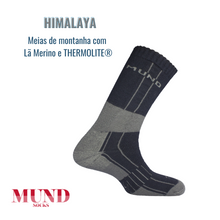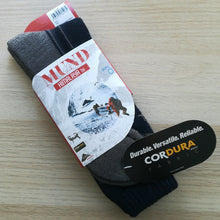
Mountain socks made with Merino wool and THERMOLITE®, whose fiber mix provides high quality and thermal capacity. Model with heel and toe reinforced with CORDURA® fiber, which offers greater resistance to wear and continuous impacts.
MUND HIMALAYA has special sweating channels on the instep to improve moisture release and on uneven terrain. At the same time, it has elastic adjustment bands on the foot to prevent the sock from moving during use and the possible appearance of blisters or rashes.
At RUNSOX we advise all hikers to wear superior quality socks. We believe that spiritual motivation and the pleasure of walking are greater when we feel good and possible physical sacrifices are minimized.
CORDURA®
Designed for life and built to last, original CORDURA® fabric is proven to perform in many of the world's toughest environments. Made with high tenacity nylon 6.6 threads. A robust, strong and water-repellent fabric.
TERMOLITE®
Technology designed to keep the user warm and dry, and helps optimize performance. Warm and light fabric, with good insulation from the cold, moisture management and breathability.
Additional features:
- No internal seams
- Reinforcement on the heel and toes
- Intermediate area with elastic band that improves fixation on the foot
- Pre-washed and softened
Composition: 35% Merino wool, 35% THERMOLITE®, 15% Polyester, 5% Cordura® fiber, 5% Lycra® fiber and 5% Polyamide.
Other RUNSOX suggestions:
The Himalayas are the highest mountain range in the world, located between the Indo-Gangetic Plain in the south and the Tibetan Plateau in the north. The mountain range covers five countries (Pakistan, India, China (which includes Tibet), Nepal and Bhutan) and is home to the highest mountain on the planet, Mount Everest. The name Himalaya comes from Sanskrit and means "abode of snow". The Himalayas spread, from west to east, from the Indus River valley to the Brahmaputra River valley, forming an arc about 2500 km long and with a width varying from 400 km in the west, in the Kashmir-Tibet region, 150 km in the east, in the Tibet-Arunachal Pradesh region. More information at https://pt.wikipedia.org/wiki/Himalaias

















